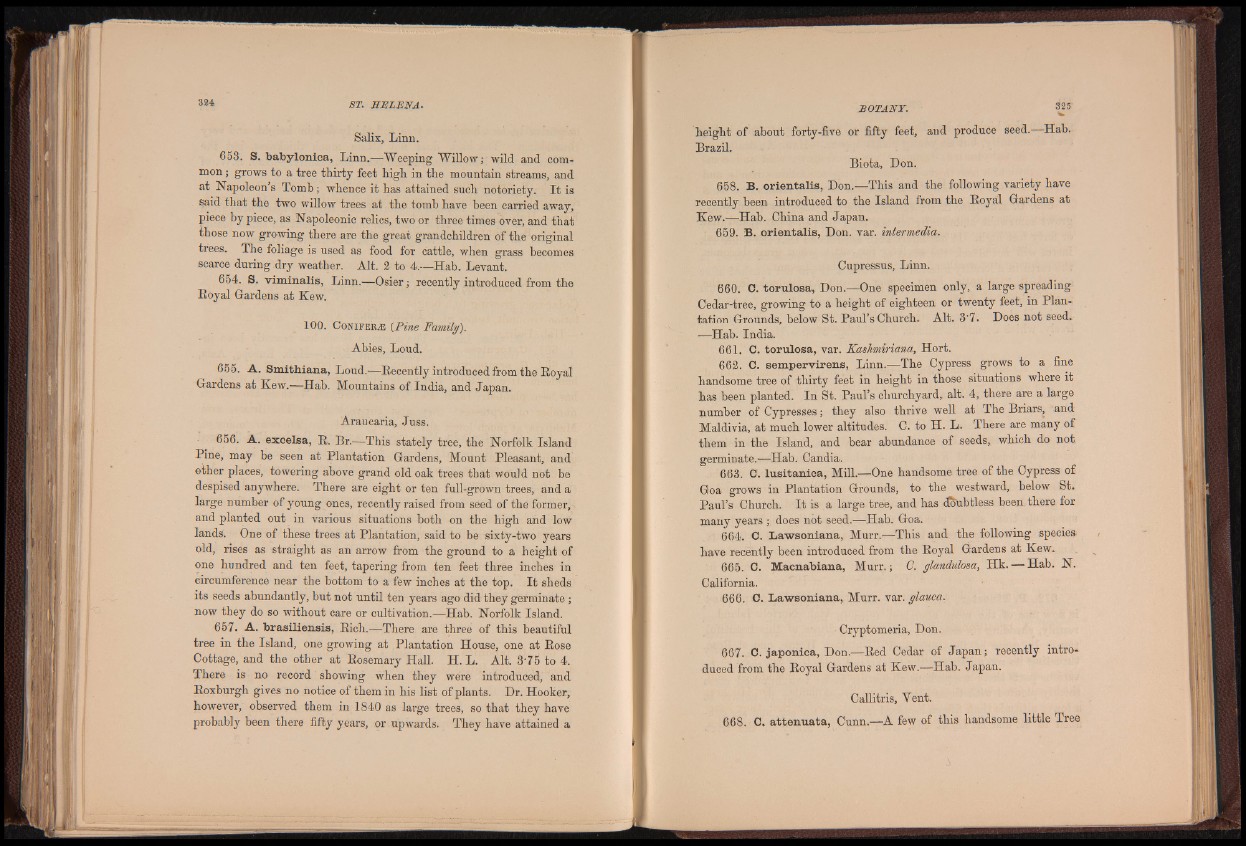
Salix, Linn.
653. S. babylonica, Linn.—Weeping Willow; wild and common
; grows to a tree thirty feet high in the mountain streams, and
at Napoleon’s Tomh; whence it has attained such notoriety. I t is
said that the two willow trees at the tomb have been carried away,
piece by piece, as Napoleonic relics, two or three times over, and that
those now growing there are the great grandchildren of the original
trees. The foliage is used as food for cattle, when grass becomes
scarce during dry weather. Alt. 2 to 4.fi*-Hab. Levant.
654. S. viminalis, Linn.—Osier; recently introduced from the
Eoyal Gardens at Kew.
100. Conifebje (Pine Family).
Abies, Loud.
655. A. Smithiana, Loud.—Recently introduced from the Eoyal
Gardens at Kew.—Hab. Mountains of India, and Japan.
Araucaria, Juss.
656. A. excelsa, R. Br.—This stately tree, the Norfolk Island
Pine, may be seen at Plantation Gardens, Mount Pleasant, and
other places, towering above grand old oak trees that would not be
despised anywhere. There are eight or ten full-grown trees, and a
large number of young ones, recently raised from seed of the former,-
and planted out in various situations both on the high and low
lands. One of these trees at Plantation, said to be sixty-two years
old, rises as straight as an arrow from the ground to a height of
one hundred and ten feet, tapering from ten feet three inches in
circumference near the bottom to a few inches at the top. I t sheds
its seeds abundantly, but not until ten years ago did they germinate;
now they do so without care or cultivation.;—Hab. Norfolk Island.
657. A. brasiliensis, Rich.—There are three of this beautiful
tree in the Island, one growing at Plantation House, one at Rose
Cottage, and the other at Rosemary Hall. H. L. Alt. 375 to 4.
There is no record showing when they were introduced, and
Roxburgh gives no notice of them in his list of plants. Dr. Hooker,
however, observed them in 1840 as large trees, so that they have
probably been there fifty years, or upwards. They have attained a
height of about forty-five or fifty feet, and produce seed.—Hab.
Brazil.
Biota, Don.
658. B. orientalis, Don.—This and the following variety have
recently been introduced to the Island from the Royal Gardens at
Kew.—Hab. China and Japan.
659. B. orientalis, Don. var. intermedia.
Cupressus, Linn.
660. C. torulosa, Don.—One specimen only, a large spreading
Cedar-tree, growing to a height of eighteen or twenty feet, in Plantation
Grounds, below St. Paul’s Church. Alt. 3'7, Does not seed.
—Hab. India.
661. C. torulosa, var. Kashmiriana, Hort.
662. C. sempervirens, Linn.—The Cypress grows to a fine
handsome tree of thirty feet in height in those situations where it
has been planted. In St. Paul’s churchyard, alt. 4, there are a large
number of Cypresses; they also thrive well at The Briars, and
Maldivia, at much lower altitudes. C. to H. L. There are many of
them in the Island, and bear abundance of seeds, which do not
germinate.—Hab. Candia.
663. C. lusitanica, Mill.—One handsome tree of the Cypress of
Goa grows in Plantation Grounds, to the westward, below St.
Paul’s Church. I t is a large tree, and has doubtless been there for
many years ; does not seed.—Hab. Goa.
664. C. Lawsoniana, Murr.—This and the following species
have recently been introduced from the Royal Gardens at Kew.
665. C. Macnabiana, Murr.; C. glandulosa, Hk. — Hab. N.
California.
666. C. Lawsoniana, Murr. var. glauca.
Cryptomeria, Don.
667. C. japonica, Don.—-Red Cedar of Japan; recently introduced
from the Royal Gardens at Kew.—Hab. Japan.
Callitris, Yent.
668. C, attenuata, Cunn.—A few of this handsome little Tree